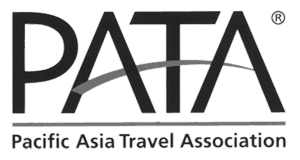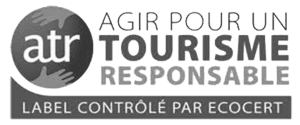Ujung Kulon National Park is located in the west of Java Island and is home to the One-horned Rhino. With a total area of 122,956 hectares, the national park combines aquatic and terrestrial areas creating a diverse ecosystem. In this area, various types of flora and fauna thrive, creating an environment rich in biodiversity. Apart from being a natural habitat, Ujung Kulon National Park also has an important role as a breeding ground for rare animals. Its abundant natural wealth makes it an attractive tourist destination.
The history of Ujung Kulon National Park begins with the first exploration by F. Junghuhn, a German botanist, in 1846. His exploration aimed to collect various types of plants from the tropics. By then, the natural richness of Ujung Kulon was widely known and this attracted several researchers to visit the area. However, there weren’t too many historical records about the area until the Mount Krakatau disaster in 1883.
The powerful eruption of Mount Krakatau triggered a tsunami with a height of up to 15 meters, which destroyed settlements in Ujung Kulon and adversely affected the local biodiversity. Despite this, the ecosystem and habitat in Ujung Kulon recovered quickly. Since then, the forest area in Ujung Kulon has been designated as a protected area.
In 1921, based on recommendations from The Netherlands Indies Society for the Protection of Nature, the Ujung Kulon Peninsula and Panaitan Island were designated as a Nature Reserve Area through Dutch East Indies Decree No. 60 on November 16, 1921 by the Dutch East Indies Government.
After various considerations regarding the importance of protecting the Ujung Kulon Peninsula, on February 26, 1992, through Minister of Forestry Decree No. 284/Kpts-II/1992, Ujung Kulon was officially designated as Ujung Kulon National Park. The National Park has an area of 122,956 hectares, consisting of a land area of 78,619 hectares and a water area of 44,337 hectares.

Credit: YouTube
Natural Conditions of Ujung Kulon National Park
Geographically, Ujung Kulon National Park is located at 06°52’17” – 06°30’43” South latitude and 105°02’32” – 105°37’37” East longitude. Administratively, the area is located in Sumur and Cimanggu Subdistricts, Pandeglang Regency, Banten Province.
The topography of this national park varies from flat, sloping, undulating, hilly, to mountainous. One of the mountains in this area is Mount Honje.
Based on the climate classification according to Schmidt and Fergusson, the climatic conditions in Ujung Kulon National Park are relatively wet throughout the year. The highest rainfall occurs between October and May, while in May the rainfall decreases again and is lowest in July.
Furthermore, in August rainfall increases again. The average air temperature in this area is in the range between 26.5 to 28.9 degrees Celsius. While the air humidity each month averages between 85% to 90%.
There are three main ecosystems in Ujung Kulon National Park which are the terrestrial ecosystem, marine ecosystem and coastal ecosystem. These three areas consist of several different areas, but are interdependent with each other.
The terrestrial ecosystem, consists of lowland tropical rainforests located in the areas of Mount Honje, Peucang Island, Panaitan Island and the Ujung Kulon Peninsula.
Meanwhile, the marine ecosystem includes coral reefs and seagrass beds that can be found in the Ujung Kulon Peninsula, Peucang Island, Panaitan Island and Handeuleum Island.
While the coastal ecosystem includes areas along the coast and mangrove forest areas located in the northeastern part of the Ujung Kulon Peninsula area.
The overall ecosystem type in this national park is divided into several types, namely the coastal forest ecosystem, mangrove ecosystem, freshwater swamp ecosystem, lowland tropical rainforest ecosystem, and grassland ecosystem.
The management of the national park applies a zoning system with eight zones. The eight zones are the core zone consisting of land and water, jungle zone, marine protection zone, utilization zone, traditional zone, religious zone and special zone.

Credit: Kompas.com
Flora and Fauna of Ujung Kulon National Park
Since long time ago, Ujung Kulon National Park has been famous as an area with abundant biodiversity. This is still the case today. This is evidenced by the many unique species of animals and plants that can be found here.
The Flora
Ujung Kulon National Park has a very abundant biodiversity. The types of flora can be divided based on the type of ecosystem in this area.
In the coastal forest ecosystem, which covers the coastal edge in the west and south, some types of flora that can be found are katang-katang (Ipomoea pescaprae), kanyere laut (Desmodium umbellatum), tarum laut (Sophora tomentosa) and also jukut kiara (Spinifex littoreus).
Moreover, hilly areas are also found several types of pandanus such as pandanus duri (Pandanus tectorius) and pandanus bidur (Pandanus bidur). There are also waru (Hibiscus tiliaceus), sea waru (Thespesia populena), cente (Lantana camara) and babakoan (Tournefortia argentea).
Vegetation in the mangrove forest ecosystem is dominated by mangrove species such as firi (Avicennia spp.), padi-padi (Lumnitzera racemosa), bakau-bakau (Rhizophora spp.), nipah (Nypa fruticans), bogem (Sonneratia alba) and pedada (Bruguiera spp.).
Meanwhile, the freshwater swamp forest ecosystem is covered by typical flora such as lampeni (Ardisia humilis), lembang (Typha angustifolia), sayar (Caryota mitis), salak (Salacca edulis), teki (Cyperus spp.) and walingi (Cyperus pilosus).
Grassland ecosystems are covered by grass species such as thatch (Imperata cylindrica), harendong (Melastoa polyanthum), Cyperus pilosus, Andropogon sp., Cyperus compactus, Panicum repens, Isachne meliacea and Panicum colonum.
The Fauna
The various animals that make up the habitat in Ujung Kulon National Park come from several groups such as mammals of 35 species, primates of 5 species, aves or birds of 240 species, reptiles of 59 species, amphibians of 22 species, pisces or fish of 142 species and insect groups of 72 species.
Some endemic animal species that inhabit this area include the Javan rhino (Rhinoceros sondaicus) whose population is only around 50 to 60 individuals with the last habitat in this national park, Javan gibbon (Hylobates moloch), surili (Presbytis aigula) and coyote (Cuon alpinus-javanicus).
Mammal groups that live here include mongoose (Paradoxurus herma phroditus), jungle cat (Prionailurus planiceps), leopard (Panthe pardus), clouded leopard (Neofelis nebulosa), banteng (Bos javanicus), deer (Muuntiacus muntjak), deer (Cervus timorensis), deer (Tragulus javanicus), pig (Sus verrucosus) and wild boar (Sus scrofa).
The primate group includes two endemic species, the Javan gibbon and Surili, the long-tailed macaque (Macaca fascicularis), the slow loris (Nycticebus coucang) and also the langur (Presbytis cristata).
Species from the aves or bird group are the hornbill (Buceros vigil), wili-wili (Essacus magnirostris), sea pigeon (Sterna bengalensis), forest cuckoo (Cospychus malabaricus), cekakak (Todiramphus chloris), hornbill (Buceros rhinoceros), snake eagle or bido eagle (Spillornis cheela), peacock (Pavo muticus) and partridge (Gallus varius).
While from the reptile and amphibian group, species that live here are green turtles (Chelonia mydas), hawksbill turtles (Eretmochelys imbricate), estuarine crocodiles (Crocodylus prosus) and monitor lizards (Varvus salvator).

Credit: triptrus.com
Activities and Tourist Destinations in Ujung Kulon National Park
Ujung Kulon National Park offers some exciting attractions for visitor. With the combined beauty of land and water, visitors can enjoy a variety of exciting activities such as exploring exotic islands, climbing mountains and venturing into vast forests.
1. Peucang Island
Peucang Island is the most crowded tourist location and is visited by many visitors to the national park. Peucang Island beach has a characteristic that distinguishes it from other beaches which it has white sand that forms a wide expanse. Here visitors can relax while waiting for dusk to come to watch the sunset.
2. Panaitan Island
This 17,000-hectare island, which is separated by a fairly narrow strait, has quite interesting tourism potential. On Panaitan Island, there are hills that are actually formed by a very pristine forest ecosystem. The ecosystem is combined with coastal forest vegetation, mangrove forest and lowland rainforest. In general, the condition of the forest on this island is still sustainable, because it has not received too much human intervention. Moreover, Panaitan Island also has white sandy beaches with rocks and clusters of coral reefs in the ocean that are very beautiful. Other than relaxing on the beach, visitors can also take water tours such as snorkeling and diving. The relatively high wave conditions in the sea are also suitable for surfing.
3. Handeleum Island
This island is located right at the northeast end of the Ujung Kulon Peninsula Beach and is one of a cluster of small islands in the location. Handeleum Island has an area of approximately 220 hectares surrounded by mangrove forests and is home to several species of animals such as deer and pythons. One of the interesting attractions on Handeleum Island is in the Cigenter area, Cikabeumbeum area and Cigenter Pasture. These three locations can be reached in only about 2 hours by using water transportation (boats or canoes) when going down the river. Here visitors can also do kayaking activities along the Cigenter River flow here. While going down the river, along the way there will be a very long tropical rainforest. When you get to the upstream part of the river, there is a trekking route among the bamboo in the form of a path that can be traveled to reach the cascading waterfall.

Credit: wisata.app
4. Badul Island
The next tourist attraction is the Badul Island, which is a tiny island due to its relatively small size and not too wide. This uninhabited island has a very beautiful underwater park. To access this island, you can only go through Sumur Village and Tamanjaya Village.
5. Ujung Kulon Peninsula
The Ujung Kulon Peninsula is known as the last habitat of the endemic Javan rhino. The area is approximately 38,000 hectares and is managed very limitedly for nature tourism purposes in order to secure and not disturb the habitat conditions of the Javan rhino. Here visitors can simply observe various types of wildlife, camping or trekking. Especially for trekking activities, the management has provided a fixed route that can be passed by visitors in the form of Guard Posts which are scattered at several points such as in Cibunar, Karang Ranjang and Cidaon. Moreover, tourists can also go down directly to observe and watch herds of animals in the Cidaon and Cigenter Pasture areas. Visitors can also set up camp at Tanjung Layar or do cultural tourism at Sang Hyang Sirah Cave.
6. Mount Honje
Tourist sites in Ujung Kulon National Park are not only limited to beaches and islands, but there are also mountains. One of them is Mount Honje which stretches for approximately 19,500 hectares. The mountain is surrounded by nineteen buffer villages, either directly adjacent to the mountain or not. Those who love climbing as a hobby can visit Mount Honje. There are also other attractions in this place, such as Cibiuk Hot Springs, Curug Pipanis, Curug Cikajang and Cibanua Fishing Village.





 Changer de langue
Changer de langue